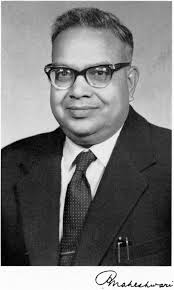Panchanan Maheshwari
Panchanan Maheshwari | |
|---|---|
 | |
| Born | 9 November 1904 |
| Died | 18 May 1966 (aged 61) |
| Alma mater | Ewing Christian College |
| Awards | FRS (1965)[1] |
| Scientific career | |
| Fields | Botany |
Panchanan Maheswari, FRS (9 November 1904 – 18 May 1966He also emphasised the need for initiation of work on artificial culture of immature embryos,
He encouraged general education and made a significant contribution to school education by his leadership in bringing out the very first textbooks of Biology for Higher Secondary Schools published by NCERT in 1964.
He is also known as father of Indian plant embryology also wrote a book- an introduction to embryology of Angiosperms
Education
Maheshwari was born at
Career
In addition to his research achievements, Maheshwari was an educator and publisher. He taught Botany at the
Maheshwari founded the scientific journal
In 1951, he founded the International Society of Plant Morphologists.[8]
He was a founding charter member of the World Academy of Art and Science, an international non-governmental organization founded in 1960 to address the major concerns of humanity.[9]
Awards and honours
Panchanan Maheshwari was a scientific citizen of the world and many academies felt honoured to make him a Foundation Fellow. In 1934 he became a fellow of the
References
- ^ .
- ^ Maheshwari, Nirmala (25 December 2004). "Remembering Panchanan Maheshwari, an eminent botanist of the twentieth century" (PDF). Current Science. 87 (12).
- ^ Gupta, Arvind. "Panchanan Maheshwari (1904 - 1966)" (PDF). Retrieved 16 January 2014.
- ^ Maheshwari, Panchanan at The Free Dictionary
- ^ "Charter Members | World Academy of Art & Science". Archived from the original on 8 March 2014. Retrieved 17 January 2014.
- ^ "LifeScience". Archived from the original on 5 January 2014. Retrieved 17 January 2014.
- ^ "Remembering my guru P. Maheshwari." N.p., n.d. Web. 8 Feb. 2017. <http://www.iisc.ernet.in/currsci/dec252004/1760.pdf>. "Maheshwari was an atheist."
- ^ ":: ISPM ::". www.ispm.co.in. Retrieved 6 June 2021.
- ^ "SHORT BIOGRAPHY OF WAAS CHARTER MEMBERS". World Academy of Art and Science.
- ^ "BIRBAL SAHNI MEDAL". Archived from the original on 21 October 2013. Retrieved 17 January 2014.
